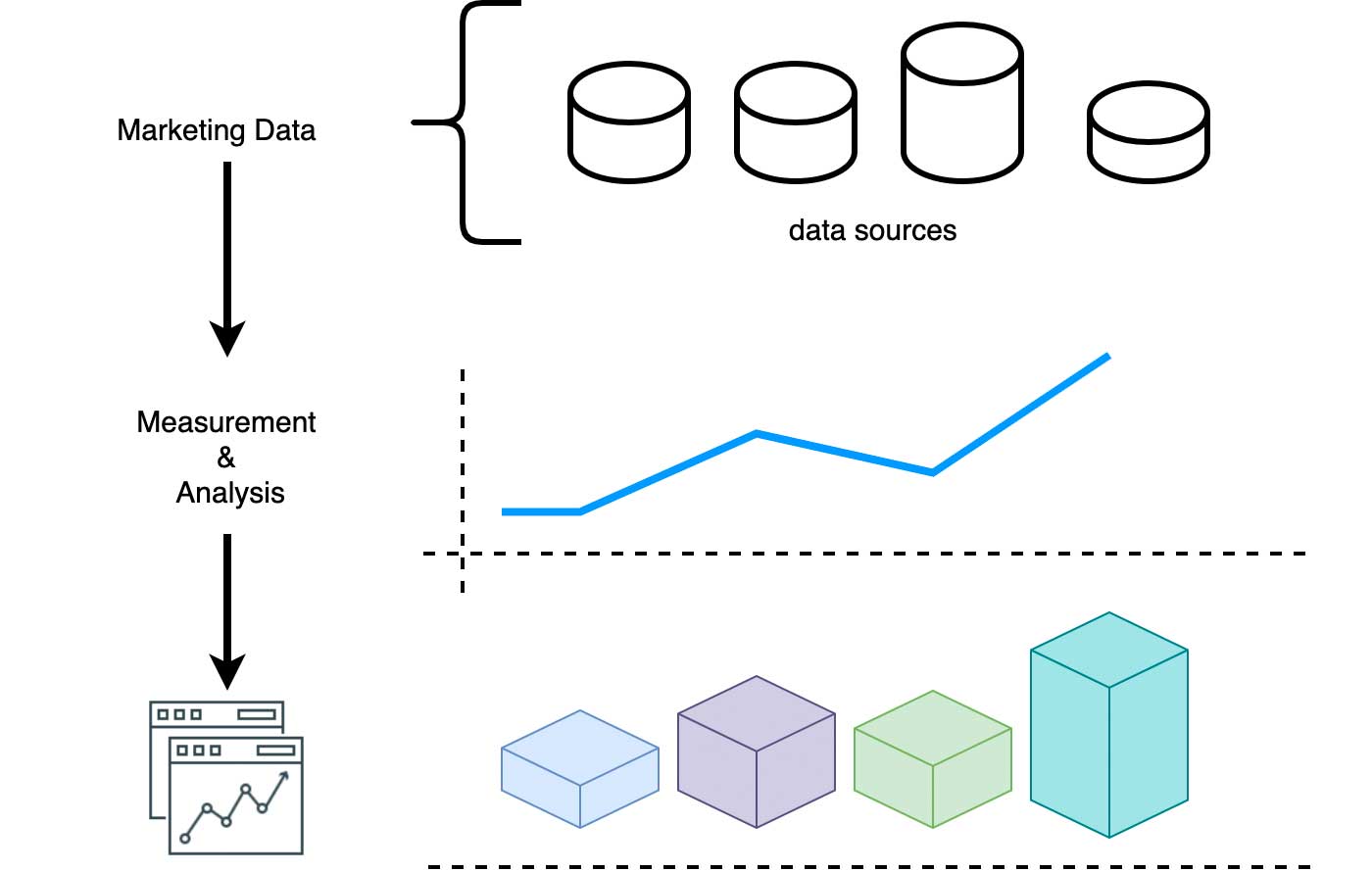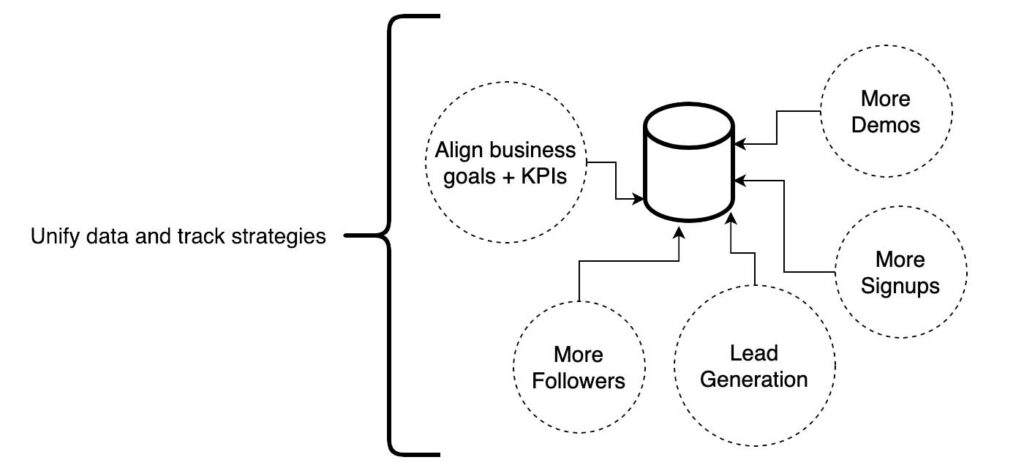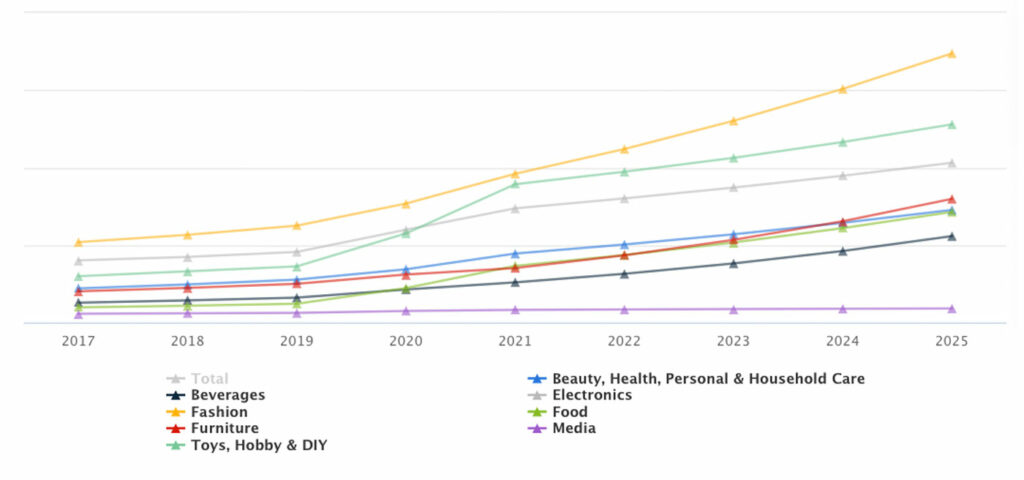Looking back at the beginning of Covid-19, we can see how quickly e-commerce grew, this growth was forecasted to occur over 10 years, instead, it only took a few months. Obviously, brands and marketers with a robust digital footing succeeded, but plenty of others did not, in hindsight, how much would brands and marketers have invested in their digital activity and infrastructure?
As a marketer, you're likely to be facing the challenge of delivering more personalised ads and content whilst juggling key factors like; better privacy, no access to third-party tracking, data collection and data analysis – sounds scary and expensive? we disagree…
What is marketing analytics?
Marketing analytics is a fusion of two factors, marketing data plus measurement & analysis.
Marketing data is the information collected about your marketing strategy, this can be your audience, messaging, channels and content.
Measurement & analysis is the process of looking at data to help you understand and evaluate, in other words – making sense of the data.
Marketing analytics becomes powerful when fused together as it offers insights into how customers interact with your marketing. It helps you uncover insights that would otherwise be hidden or difficult to find.

Where do I start for a data-driven strategy?
As mentioned earlier, data is at the core of a data-driven strategy, in this strategy, we’ll keep it simple by separating the process into three parts.
- Data collection – First, you must begin with data that is relevant to you.
- Data storage & processing – Second, where you will host the data to view, store, retrieve and process.
- Analytics – Third, is how to view and understand the data.
1 – Data collection
How do I collect data from customers?
For data to be highly relevant there are only two ways to get it, by purchasing it from a reputable source, which may be expensive and not entirely adequate, or by collecting it, this is our prefered route, why? because it’s highly relevant, specific and low cost.
Purchased data is highly likely to be large in size, with a large number of records, but it may lead you where you first started, as it may not contain what you are looking to uncover. Building your own data is the alternative, if you’ve never collected data before your data will need to be collected from scratch, fortunately, these days data collection is easier and more affordable.
There are so many tools to choose from, great! – well, not quite…
What tool should you use for a data-driven strategy? Ironically, there are too many products available for a simple answer to this question, instead, we’ll try to focus on how to create a solution for anybody looking for an entry-level with minimum costs and resources.
Too many products – isn’t that great! – well, not really, the marketing technology landscape is large, as of 2022 there are approximately 9,932 software solutions – see the martechmap. The choice is clearly abundant, but overwhelming.
Tools for high-quality data collection
Before you begin to look for data collection tools, let’s quickly understand some of the basics of what makes ‘high-quality data’.
-
Complete – The level of detail at which data is collected is important, This includes the most critical information you need, otherwise confusion and inaccurate decisions can otherwise occur. An appropriate level of granularity must be available for detailed analysis.
-
Consistent – Having data stored across multiple locations may not provide a clear picture when making an analysis. Having access by different individuals to the same data is also important. This ensures clarity and speed when reporting to management/stakeholders.
-
Correct – Incomplete data is as dangerous as inaccurate data, eventually making your marketing strategy expensive due to the waste associated with the resources and off-targeting.
-
Current – To measure the accuracy of a marketing strategy data needs to be relevant, If data is collected too soon or too late it could misrepresent a situation and drive inaccurate decisions.
-
Compliant – Data privacy and the de-identification of information must be considered for security and to avoid legal trouble or customer mistrust.
Now that you have a basic understanding of the type of data required we can narrow the search, please note, the following recommendations are for a data-driven marketing strategy, there are multiple marketing and BI solutions that can accomplish this and much more, in our case, these offer great results with very little costs and experience to integrate.
Top 4 tools for data collection.
1 – Matomo Analytics (formerly Piwik) | matomo.org
Matomo Analytics allows you to collect and view data using dashboards, they have a cloud solution with the option to purchase plugins to tailor your marketing needs. Matomo also makes the process of data collection even simpler with plugins available for WordPress, this makes your integration incredibly simple and fast.
If you have access to developers, Matomo offers an on-premise open-source version, it’s free and gives you full control, security and provides you with 100% data ownership – click on the link if you want to find out more about matomo and their free open-source version.
2 – Sigma | sigma.com
Like Matomo, Sigma allows you to view and analyse your data in greater detail. It also offers a great set of features, including creating dashboards and the ability to drill and query into data. Sigma also has the ability to easily connect with Snowflake. This is a great solution if you are looking for a live connection that is always up to date and extremely quick.
3 – Mparticle | mparticle.com
Mparticle is another great solution to collect data from multiple sources into a single location, they also offer the flexibility to enrich your data, which means that you can collect extra information from a single event for granular analysis – simply put, it helps you know more about your users without asking them for extra information.
4 – Snowflake | snowflake.com
Snowflake enables data storage, processing, and analytic solutions that are faster, easier to use, and far more flexible than traditional offerings.
This solution is much more flexible in terms of enrichment and pricing but will require a visualisation tool to understand and view your data, and likely need access to developers/engineers. As mentioned above, a Snowflake connection with Sigma can provide a winning solution for the collection, storing and analysing of data.
No mention of the top brands?
There are some great products that you may have already heard of or used, unfortunately, what makes these products not relevant in our strategy is that they come with a high cost. These include;
Marketo, Google 360, Adobe Analytics, Kissmetrics.
What about some of the free tools available, like google analytics?
The reason Google Analytics(GA) is not included, is the data, the data provided in the free version is always aggregated, and not raw. What does that mean for you? in simple words, the data is summarized and will lack the valuable details required by you, also, it’s much harder to run sophisticated analysis, and finally, you won’t have access to export your raw data.
2 – Data Storage and Processing
This topic is large and complex, but in our case, we’ll keep it short and relevant to our strategy.
When it comes to this subject, we highy recommend using a proven solution that handles all aspects of data storage and processing, this will help you eliminate hours of development and integration costs.
The key elements you need to look for in a well-rounded data solution are:
- Flexibility – full control of what and how data is collected.
- Streaming – ability to send data uninterrupted from sources.
- Low maintenance – zero to very little data operations required.
- Security & compliance – data anonymization, plus option to store data in appropiate region (country).
- Easily accesible – Data export and sharing.
- Ownership – All data collected should be owned by you – 1st party data.
What about processing?
In the context of what we’re trying to achieve, Processing, or Data Processing, is transforming raw data into a meaningful output. This process requires software and hardware talking to each other in order to function, CPU time is a key factor in this process and one that requires experience to avoid issues that can eventually cost more in the long run.
To bypass the complexity of data processing we have included it as an ‘out-of-box’ feature in the tools mentioned above.
3 – Analytics
Now that you have collected customer data you can begin to understand it, to do so, we now need an analytics integration that include measurement and analysis tools.
To make your data-driven marketing strategy complete the following key elements should be included in your analytics solution;
- Tracking – See the activity across web pages and other digital sources, eg; opened emails, signups, purchases, etc.
- Data query – Question or a request for information from the data – without altering the source.
- Count & count unique – Total number of events for a given collection.
- Sum, average, maximum & minimum – Run calculations.
- Median, percentile, unique – Calculation and unique values for a given property.
- Standard deviation – Better accuracy & account for widely varying factors, eg; clicks, costs, sales, etc. – watch this video for a great explanation on standard deviation.
- Filtering – Exclude, rearrange, or apportion data according to certain criteria.
- Cohort analysis – Categorise and divide data into groups with common characteristics for analysis.
- Visualisation – View, share, and embed data using dashboards.
- Access & Sharing – Ability to export and share data without complicated integrations.
- Real Time – Access to data from activity that occurred within seconds.
In the following section we’ll list tools that can help you understand your data and without requiring to write complex queries using code, in other words, these tools allow you to access data with easy to use interfaces.
Top 4 tools for data visualisation.
1 – Domo | domo.com
Domo lets you combine all your data and create analytics and data apps to drive insight-based actions. Domo serves enterprise customers in all industries looking to manage their entire organization from a single platform.
2 – Tableau | tableau.com
Tableau and Domo are similar when it comes to analytics, Tableau’s goal is to allow anybody access to big data. Tableau has 3 main products Tableau Desktop, Tableau Server, and Tableau Online.
For a complete data-driven marketing strategy you will need to include these modules into your subscription.
Tableau Creator, Explorer & Viewer.
3 – Microsoft PowerBI | powerbi.microsoft.com
A top-ranked solution in business intelligence tools, Microsoft BI is similar to Tableau in that it can turn data from multiple sources into insightful and useful business information, It has an easy-to-use interface and the ability to produce reports and easy connections to other Microsoft products.
Microsoft BI provides multiple pricing levels, including a free version to get you started. To visualize and access your data at a granular level you are likely to require a premium account.
4 – Qlik | qlik.com
Qlik provides you with great flexibility and configuration options for data, This solution is more suited if you have access to developers to build custom solutions.
Qlik has various pricing and modules available and your choice will depend on your specific needs. Qlik offers a free trial of their analytics solution, Qlik Sense Business.

Summary
The benefits of a data-driven strategy are no longer exclusive to large brands or agencies, there are plenty of great tools and resources available to find a solution that fits your unique goals, however, this process will require a level of flexibility, development and creativity to succeed.
The growth of e-commerce and digital advertising continues, In Australia, revenue in the eCommerce market is projected to reach US$46.68bn in 2022, and is projected to grow by 14.11%, resulting in US$69.35bn by 2025 (view source), which means, more opportunities but also more competition – we believe these are exciting times and great opportunities for digital marketing.
Our recommended solution?
The good news is that starting out is a relatively low-cost process with tools like Matomo Analytics, you can be up and running with almost no disruption, plus, if you have access to developers, you can run Matomo on your own server with full control, to find out more visit Matomo On-Premise.
What to avoid?
One of the traps to avoid is simply collecting all possible data with the intention of analysing it in the future, this can be counter-productive and may end up costing you more.
Will collecting & analysing data turn your marketing into an instant success?
Regardless of how sophisticated your tools are, without a good marketing strategy, clear goals and monitoring you will find yourself without much success, ultimately these are just tools that require your marketing knowledge to excel.
What marketing analytics and measurement tools do extremely well is measure and help you uncover marketing insights easily, in seconds, rather than hours or even days.







